
Rambutan is a medium-sized tropical tree in the family Sapindaceae. The name also refers to the edible fruit produced by this tree. The rambutan is native to Southeast Asia. It is closely related to several other edible tropical fruits, including the lychee, longan, pulasan, and quenepa.

Dimocarpus longan, commonly known as the longan and dragon's eye, is a tropical tree species that produces edible fruit. It is one of the better-known tropical members of the soapberry family Sapindaceae, to which the lychee and rambutan also belong. The fruit of the longan is similar to that of the lychee, but is less aromatic in taste.

The persimmon is the edible fruit of a number of species of trees in the genus Diospyros. The most widely cultivated of these is the kaki persimmon, Diospyros kaki – Diospyros is in the family Ebenaceae, and a number of non-persimmon species of the genus are grown for ebony timber. In 2022, China produced 77% of the world total of persimmons.
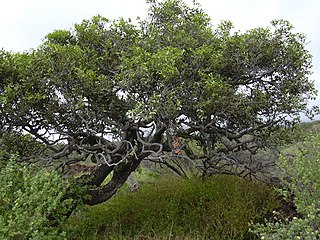
The Ebenaceae are a family of flowering plants belonging to order Ericales. The family includes ebony and persimmon among about 768 species of trees and shrubs. It is distributed across the tropical and warmer temperate regions of the world. It is most diverse in the rainforests of Malesia, India, Thailand, tropical Africa and tropical America.
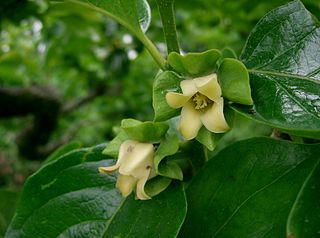
Diospyros is a genus of over 700 species of deciduous and evergreen trees and shrubs. The majority are native to the tropics, with only a few species extending into temperate regions. Individual species valued for their hard, heavy, dark timber, are commonly known as ebony trees, while others are valued for their fruit and known as persimmon trees. Some are useful as ornamentals and many are of local ecological importance. Species of this genus are generally dioecious, with separate male and female plants.
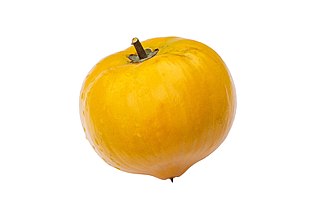
Pouteria campechiana is an evergreen tree native to, and cultivated in, southern Mexico, Belize, Guatemala, and El Salvador. It is cultivated in other countries, such as India, Costa Rica, Brazil, the United States, the Dominican Republic, Australia, Cambodia, Vietnam, Indonesia, Sri Lanka, Nigeria, and the Philippines. The edible part of the tree is its fruit, which is colloquially known as an egg fruit.
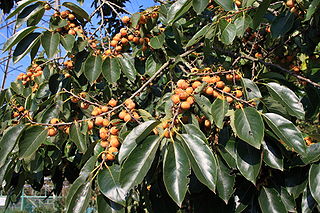
Diospyros lotus, with common names date-plum,Caucasian persimmon, or lilac persimmon, is a widely cultivated species of the genus Diospyros, native to temperate Asia and southeast Europe. Its English name derives from the small fruit, which have a taste reminiscent of both plums and dates. It is among the oldest plants in cultivation.

Diospyros mespiliformis, the jackalberry, is a large dioecious evergreen tree found mostly in the savannas of Africa. Jackals are fond of the fruit, hence the common names. It is a member of the family Ebenaceae, and is related to the true ebony and edible persimmon.

Diospyros nigra, the black sapote, is a species of persimmon. Common names include chocolate pudding fruit, black soapapple and zapote prieto. The tropical fruit tree is native to Mexico, Central America, and Colombia. The common name sapote refers to any soft, edible fruit. Black sapote is not related to white sapote nor mamey sapote. The genus Diospyros has numerous other fruit bearing tree species in addition to the persimmons and black sapote.

Bouea macrophylla, commonly known as gandaria or plum mango or mango plum in English, is a species of flowering plant native to Southeast Asia. The tree belongs to the family Anacardiaceae which also includes mango and cashew.

Diospyros texana is a species of persimmon that is native to central, south and west Texas and southwest Oklahoma in the United States, and eastern Chihuahua, Coahuila, Nuevo León, and Tamaulipas in northeastern Mexico. Common names include Texas persimmon, Mexican persimmon and the more ambiguous "black persimmon". It is known in Spanish as chapote, chapote manzano, or chapote prieto, all of which are derived from the Nahuatl word tzapotl. That word also refers to several other fruit-bearing trees.
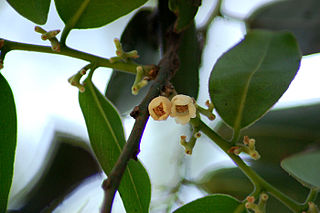
Diospyros malabarica, the gaub tree, Malabar ebony, black-and-white ebony or pale moon ebony, is a species of flowering tree in the family Ebenaceae that is native to the Indian Subcontinent and South East Asia.

Diospyros diepenhorstii is a tree in the family Ebenaceae. It grows up to 30 metres (100 ft) tall. Twigs are brownish to blackish. The fruits are obovoid to oblong-ellipsoid, up to 10 cm (4 in) long. The tree is named for Dutch botanist H. Diepenhorst. Habitat is forests from sea-level to 1,800 metres (6,000 ft) altitude. D. diepenhorstii is found in Peninsular Thailand and from west Malesia to the Philippines.

Diospyros kurzii is a tree in the family Ebenaceae. It grows up to 30 metres (100 ft) tall. Twigs dry to black. The fruits are ellipsoid, up to 1.2 cm (0.5 in) long. The tree is named for the German botanist and curator W. S. Kurz. Habitat is lowland forests. D. kurzii is found in the Andaman and Nicobar Islands, Burma, Thailand, Peninsular Malaysia, Borneo, the Philippines and Maluku.
Diospyros lanceifolia is a tree in the family Ebenaceae. The specific epithet lanceifolia means 'lance-shaped leaves'.
Diospyros lateralis is a tree in the family Ebenaceae. It grows up to 17 metres (60 ft) tall. Inflorescences bear up to three flowers. The fruits are round to ovoid, up to 2.6 cm (1 in) in diameter. The specific epithet lateralis is from the Latin meaning 'lateral', referring to the position of the inflorescences on the stem. Habitat is lowland mixed dipterocarp forests. D. lateralis is found in Thailand, Sumatra and Borneo.
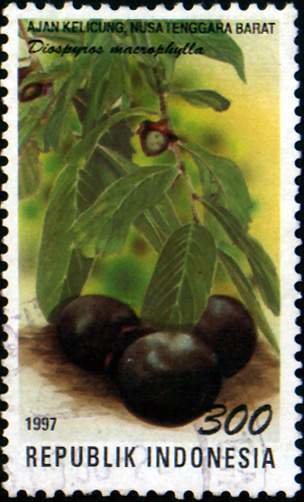
Diospyros macrophylla is a tree in the family Ebenaceae. The specific epithet macrophylla means 'large-leafed'.
Diospyros pyrrhocarpa is a tree in the family Ebenaceae. It grows up to 23 metres (80 ft) tall. Twigs dry greyish to brownish. Inflorescences bear up to three flowers. The fruits are roundish to ovoid-ellipsoid, up to 5 cm (2 in) in diameter. The specific epithet pyrrhocarpa is from the Greek meaning 'fiery red or yellow fruits'. Habitat is lowland mixed dipterocarp forests. D. pyrrhocarpa ranges from the Andaman and Nicobar Islands through Thailand, Peninsular Malaysia, Sumatra, and Borneo to the Philippines. In Cebu and Negros Regions in the Philippines, the tree is commonly known as Kunalum.
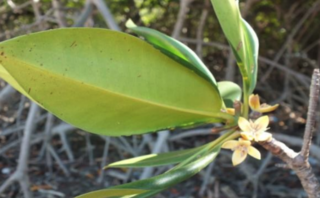
Ceriops decandra is a mangrove plant of tropical Asia in the family Rhizophoraceae. The specific epithet decandra is from the Greek meaning 'ten male', referring to the flower having ten stamens.

Diospyros paniculata, or the panicle-flowered ebony, is a species of tree in the ebony family. Endemic to the Western Ghats area of India and parts of Bangladesh, the species is currently listed as Vulnerable in the IUCN Red List.



















